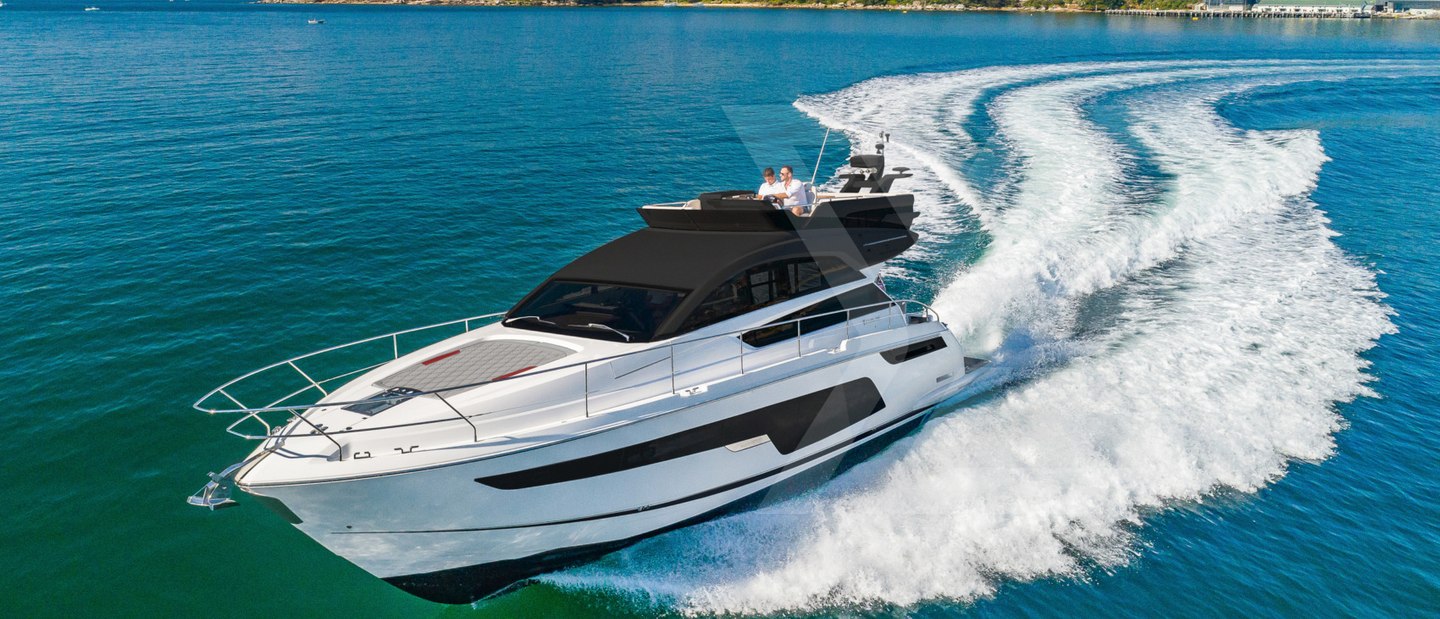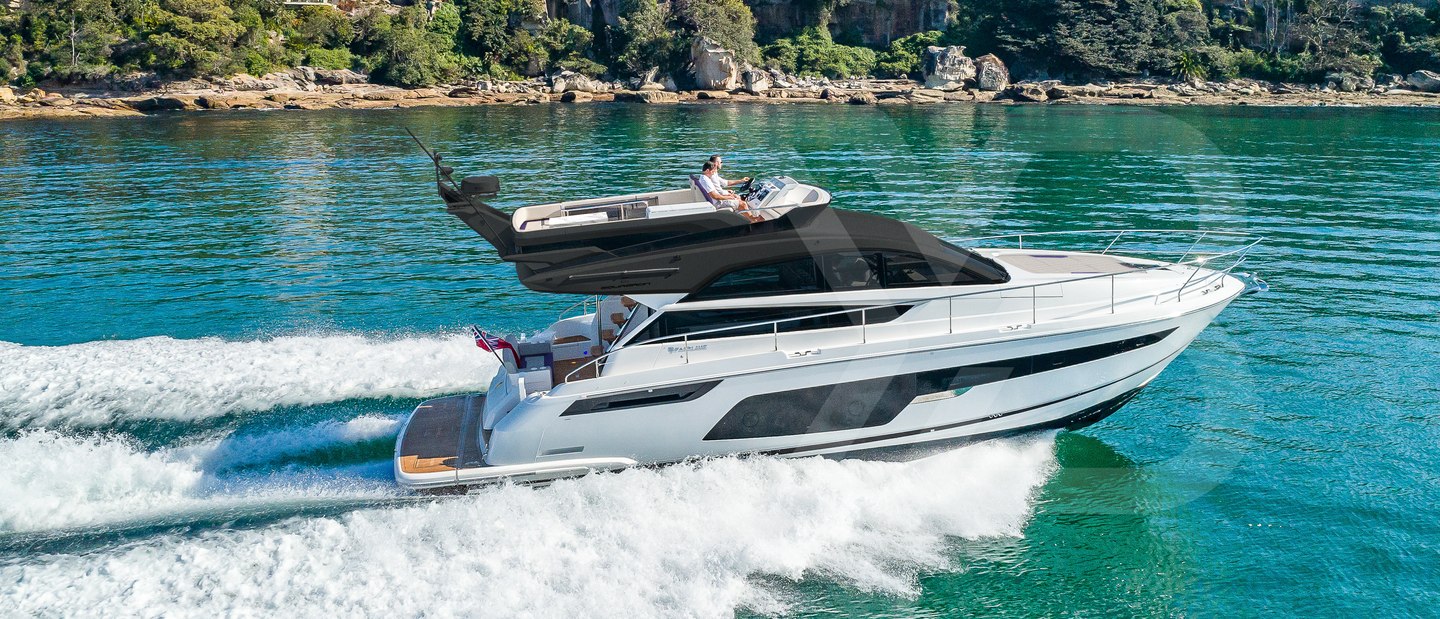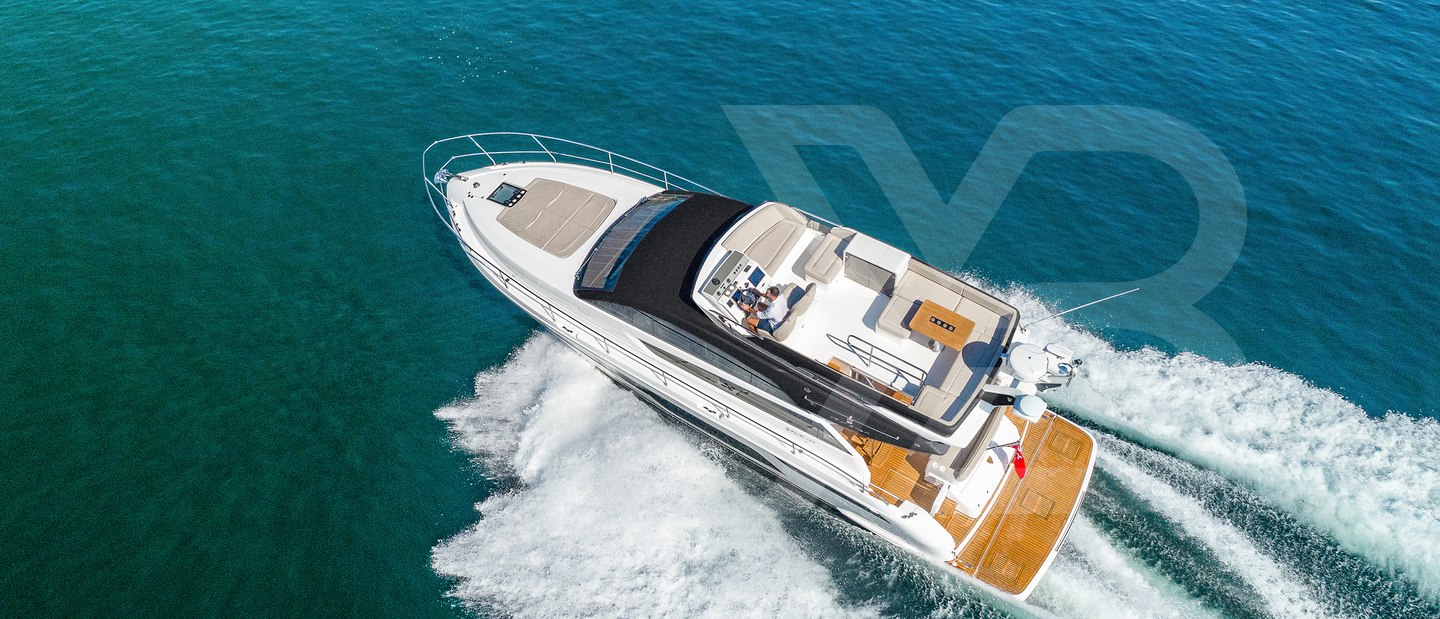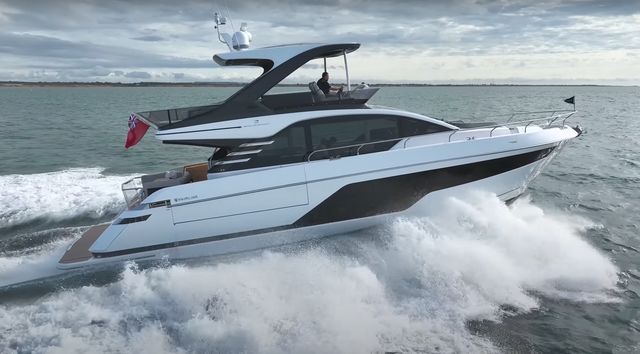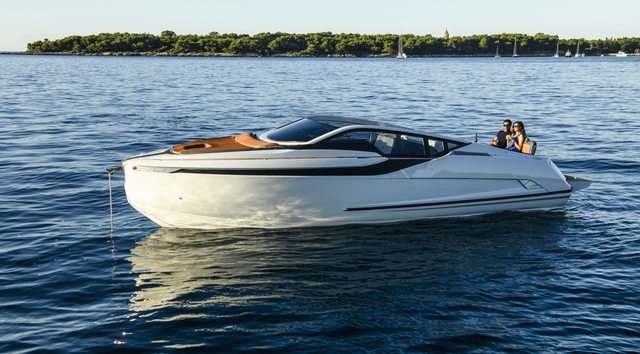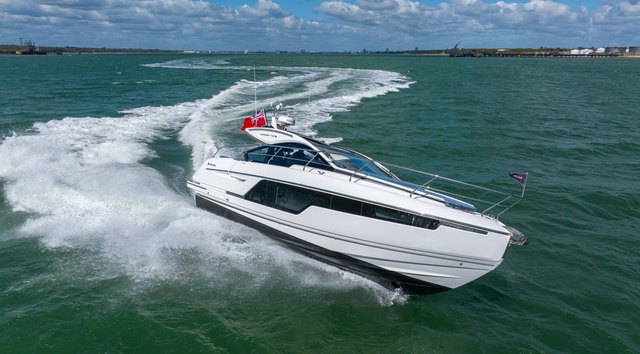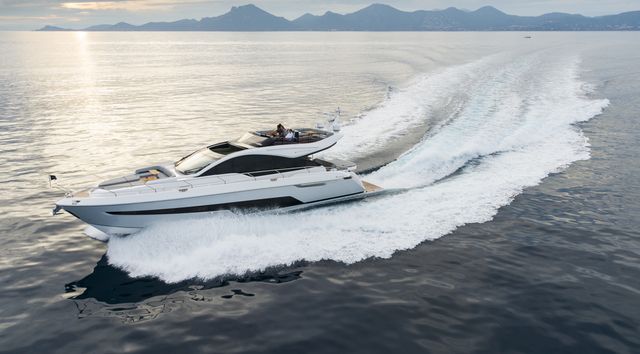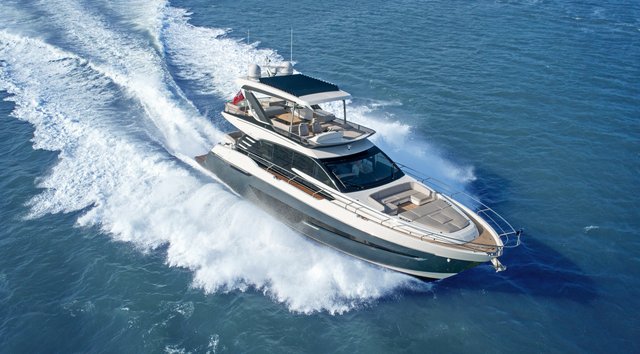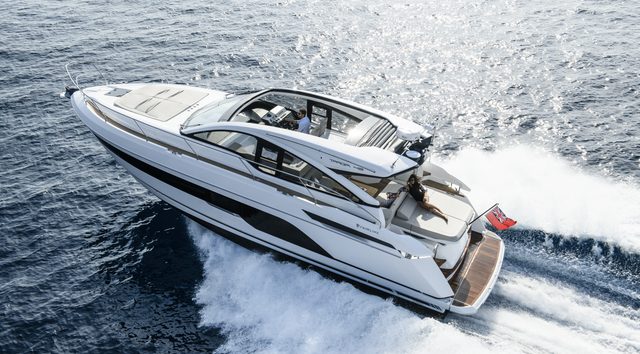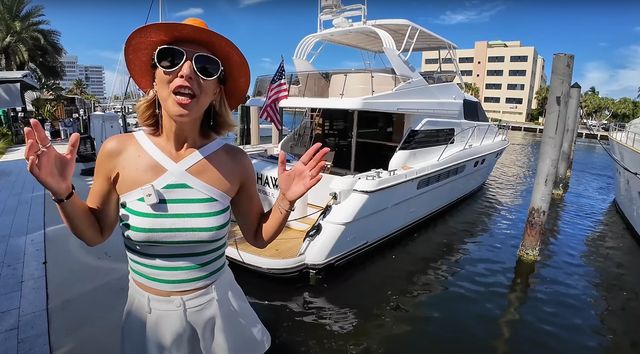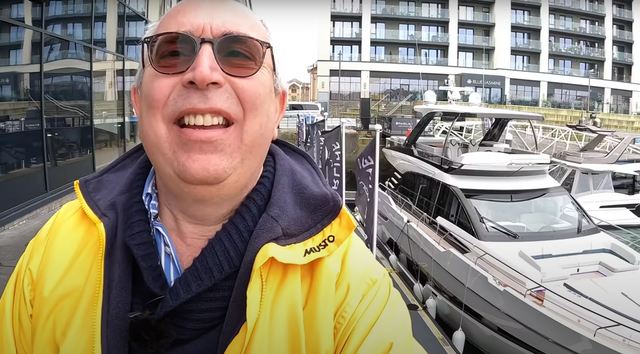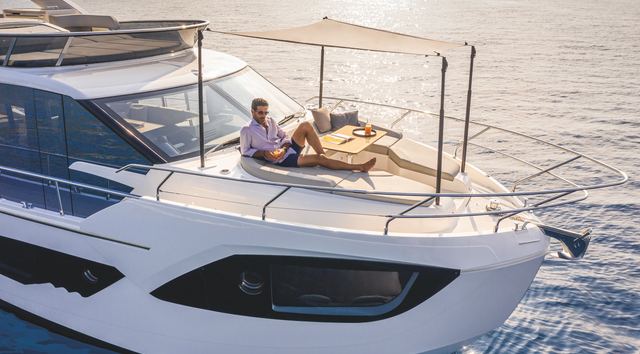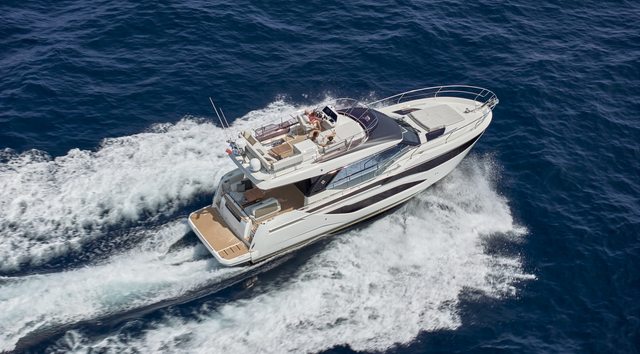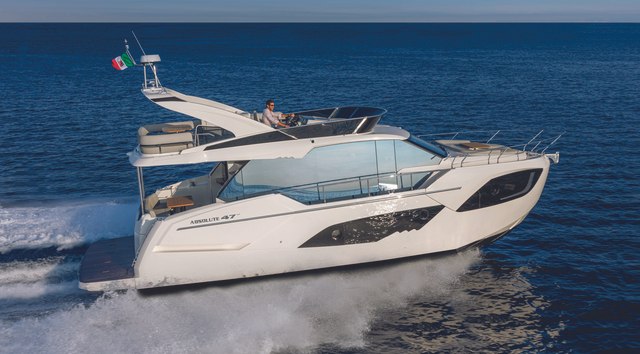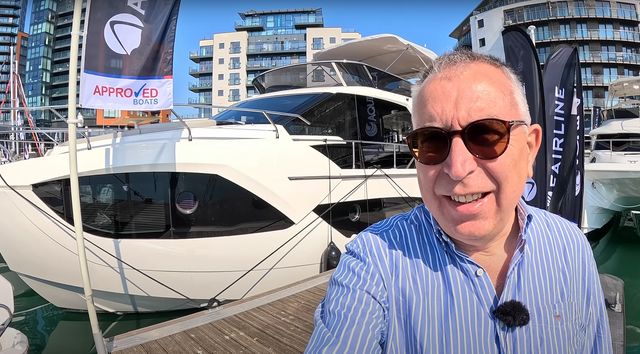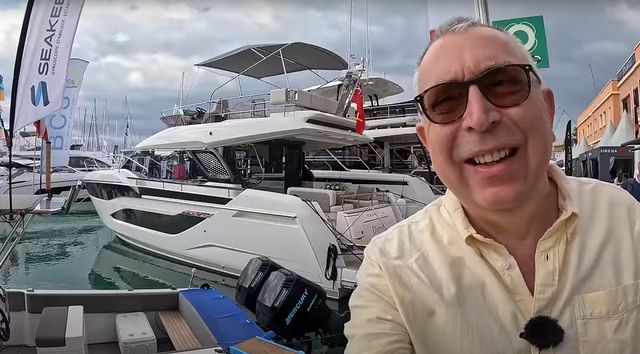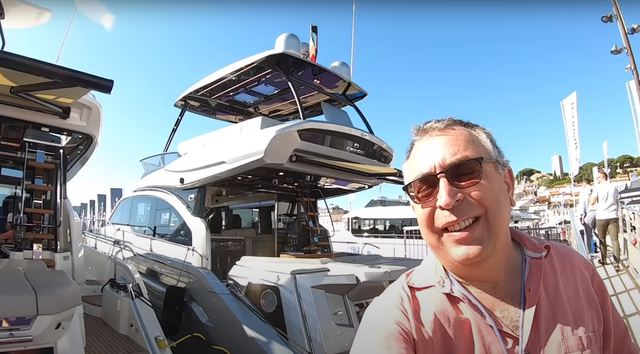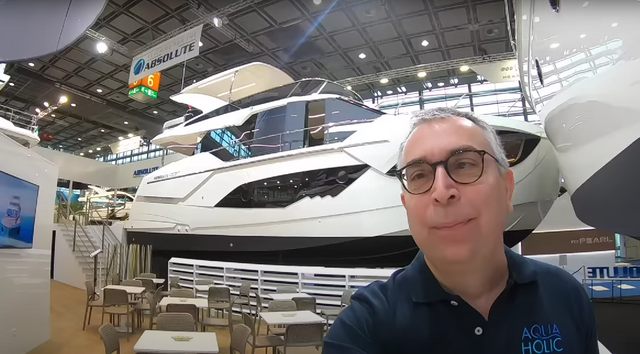Sharing a platform with the Targa 50 GT and Targa 50 Open sportscruisers, the IPS-powered Squadron 50 is bristling with practical detailing and exhibits the usual Fairline quality and attention to detail.
The sleek exterior packs in a two or three-cabin interior with the option to have the galley on the main or lower deck while two Volvo Penta IPS engine options deliver 30-knot plus performance. Keep reading this review to find out more about the Squadron 50's deck and interior spaces and what it's like out on the water.
Test & Review Video
Around the Marina
As long as you are used to steering with a joystick then the Squadron 50 is a very docile machine to guide around a marina. The view isn't great from the lower helm, though, so most of the slow-speed handling is likely to be done from the flybridge. Here, sight lines are excellent and it's easy to place the boat into its berth. The bow thruster, which is fitted as standard, is a welcome addition because, despite having finger-tip pod-drive control, there are occasions where having independent control of the bow comes in really handy.
The Squadron is on a relatively compact footprint for a flybridge of this size so it doesn't feel intimidating to handle or crew at slow speeds. It would be nice if there were better access to the decks from the helm, though, and there is a very big step up onto the foredeck from the side decks, which can take some getting used to.
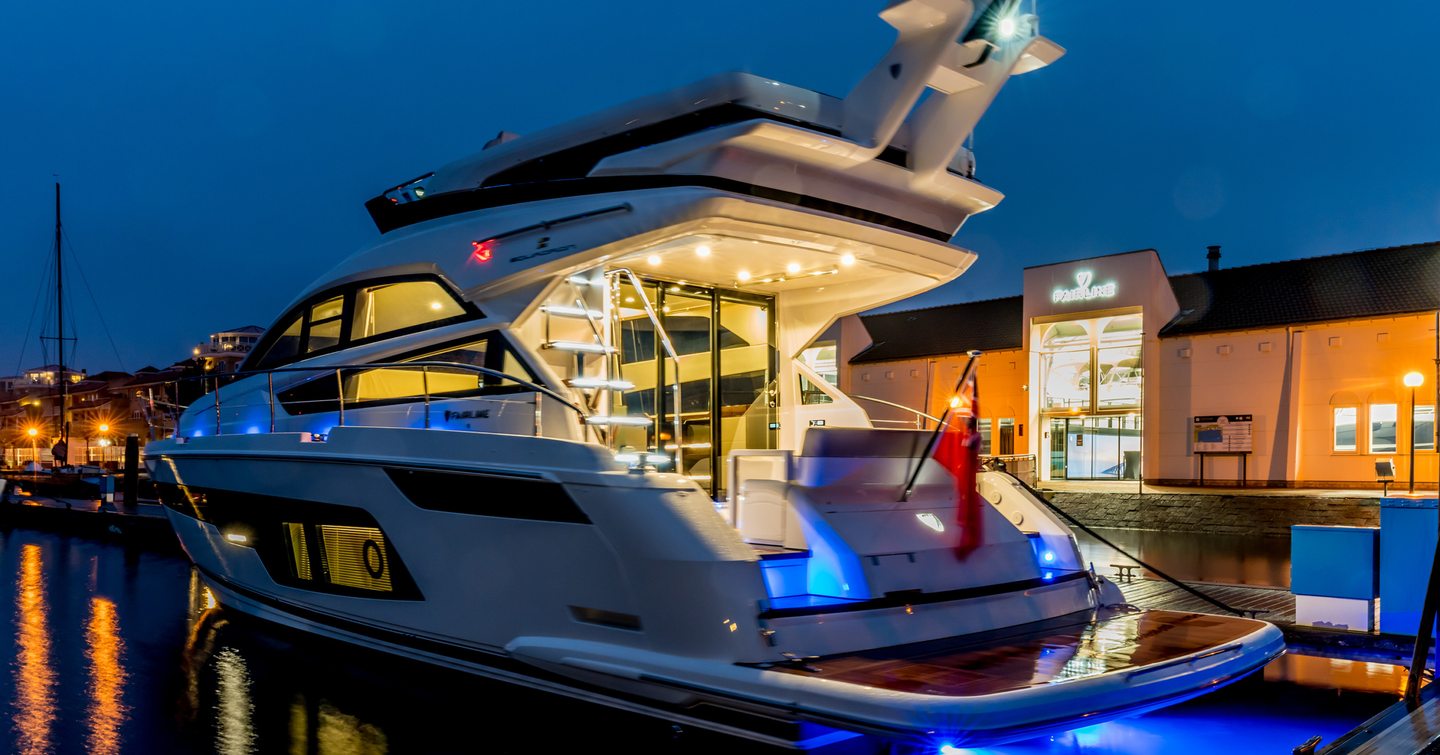
At Sea
The Squadron 50 is only available with IPS, either IPS650 with 480hp per side or IPS700 with 550hp. Of the boats built thus far, the smaller engines have been overwhelmingly the more popular, which somewhat goes against the grain. Usually, the larger engines are the automatic option when customers are speccing their boats but the mix of decent performance from the smaller motors and the fact they cost GBP £40,000 less than the larger ones make the difference here.
You should expect 30 knots from the IPS650s and a shade more from the 700s but our test boat, fitted with the former, achieved a whisker over 25 knots at WOT. In fairness, the boat had been sitting in the water for some time so it's likely that there was a fair bit of growth on the hull and props, hindering performance. Either way, 22 knots feels like the cruising sweet spot where progress is smooth, sound levels are measured and the range is in the region of 200nm.
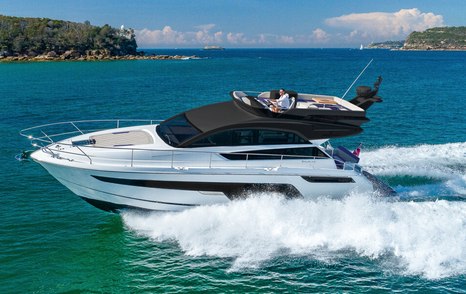

The fly-by-wire steering is super light from both helms but the turn-in has more urgency than other IPS rivals from Prestige and Absolute. You don't get the keenness in turns that an equivalent shaft drive boat would have but for an IPS boat that 50 reacts nicely from both helms and is easy to thread through the waves. Not that there were many waves to be seen in the Solent on the day of our test but any wash the boat was confronted with was dispatched solidly.
It's not what you'd call exciting to drive but performance is smooth and the hull dynamics are reassuringly solid.
The Squadron 50 was launched in 2019 and is based on a previous model, the Squadron 48, so in design terms, it's beginning to feel a little behind the curve. The use of space on board isn't as good as more current rivals and this is most noticeable on the foredeck where there is a simple sun pad and not the more usable table and sofa arrangement that many competitors have incorporated into their designs.
The Squadron is part of a three-boat platform design, off which Fairline builds the Targa 50 GT and Open so there are elements of compromise here. The lower helm, for example, will work just fine on the sportscruisers where there is a sunroof overhead but on the Squadron the view out isn't great and the windscreen is a little shallow to sit comfortably with clear sight over the bow.



The flip side is that because of this platform share Fairline has built a couple of hundred 50s in one of the three guises so the quality and consistency of the build are very good indeed. Fairline's reputation for quality and attention to detail shines through and there is an impressive amount of flexibility regarding the layout, which is pretty unique for a production boat of this size.
The black flybridge molding is the most striking aspect of the exterior design, the purpose of which is to trick the eye and lower the boat's visual height. It works, too, with only Princess's F55 rivaling the Squadron for the most pleasing proportions in the sector.
There is the option to have the galley on the main deck or lower deck inside the Squadron 50 and both have their merits. Having the galley on deck is a more sociable arrangement and makes it easier to grab food and drink from the outside while having it on the lower deck keeps the kitchen mess out of view and creates more space in the saloon for either an extra sofa or a sideboard with storage and a place to mount the pop-up TV.
Our test boat had the former and it feels like a good arrangement given the size of the saloon. Having the galley on the lower deck allows it to spread out a bit more and crates room for a domestic fridge/freezer and some really useful pop-out storage racks for stowing tinned food and other dry stores.
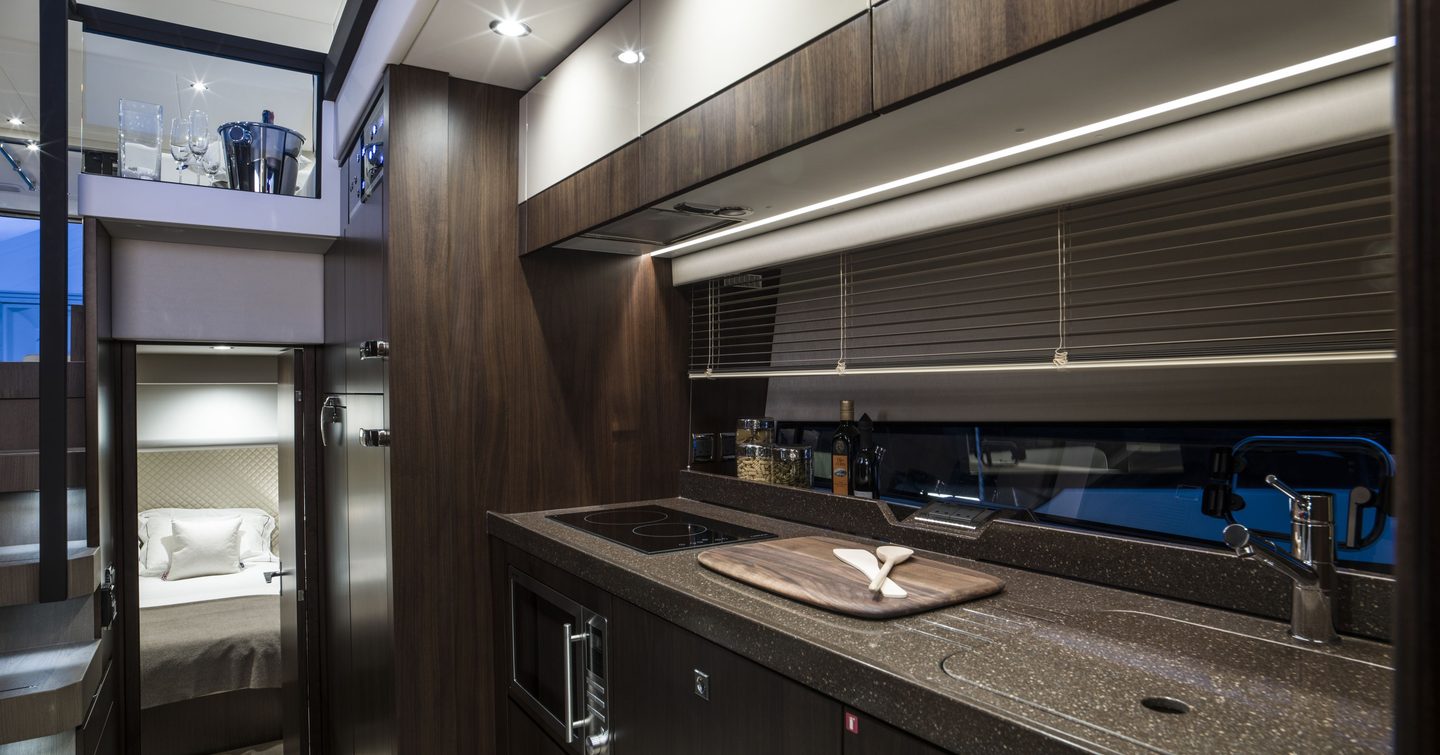


Opposite the galley, there is the option to have either a small lower dinette or an extra cabin with a pair of bunks inside. Which option you go for will likely be swayed by which version of the 50 you've chosen. On the Squadron 50 and Targa 50 GT, with their plush upper saloons, the lower dinette seems surplus to requirements but if you have the open-backed Targa 50 Open then a lower saloon with full protection from the elements would be a good idea. For most, the extra sleeping space of the third cabin with the potential to be used as a storage space/walk-in wardrobe if it's not occupied by guests will probably win out.
Either way, the VIP and master suites are spacious and comfortable with double cabins with ensuite access to their own bathrooms. Standard scissor-action berths in the VIP mean it can transform from a double to a twin in seconds, adding to the cabin's versatility. Additionally, the saloon table on the main deck drops down and uses an in-fill cushion to create an occasional double berth, meaning you could sleep nine adults (if you include the crew cabin) on this boat.


The quality of the fit-out and specifically the woodwork shines through once again on the lower deck; the quality of the gloss walnut woodwork on our test boat was outstanding.
A single crew cabin is an option but it's not the most pleasant place to spend time and, given the size of the boat, it's probably more useful to have the standard storage void where you can stow bulkier cruising gear.
The lower and upper helms share almost identical layouts so the controls are familiar at either one. They are stylish and clearly laid out with a nice mix of digital instrumentation and classy analog dials. Unlike many rivals, the MFD isn't marooned at the top of the dash but instead mounted low, opposite the navigator. This is a smart move because it means that the navigator can use the screen really easily but it is still within reach of the skipper if they need to use it.
The wheel itself somewhat obscures the screen behind the steering wheel but it is useful to have a separate albeit smaller screen to show the engine instrumentation.
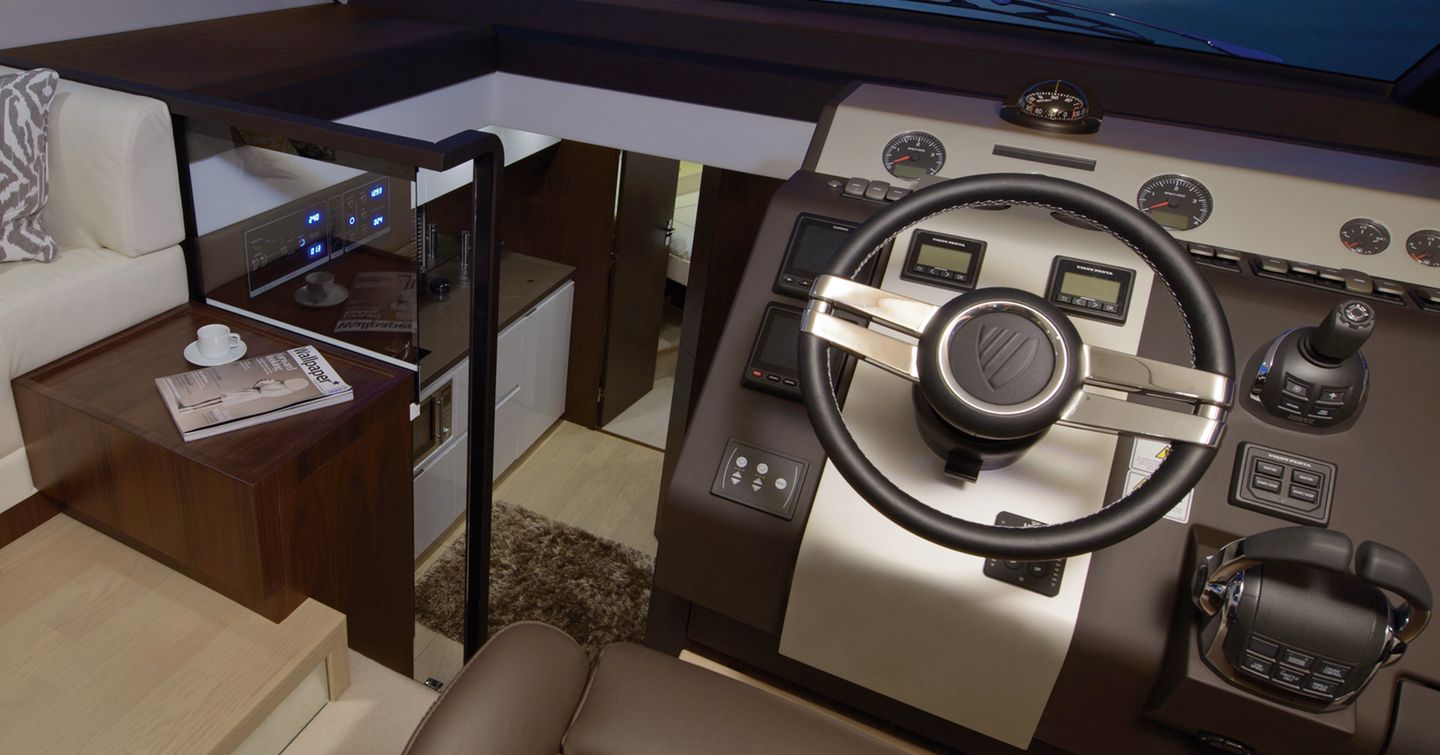
Adjustment is good at both helms thanks to a sliding seat mechanism and adjustable steering wheels but the view out from the lower helm is rather compromised. This comes back to the platform-sharing arrangement, where no doubt the geometry works well on the sportscruisers which both have a large sunroof that you can open and poke your head out of. On the Squadron the windscreen is shallow and anyone of 6ft or above will have to perch on the edge of the helm seat and stoop their head awkwardly to have a clear view forward. This isn't helped by the fact that there isn't a side door at the helm, just a small window.
All-in-all, the lower helm feels a little compromised so most of the driving is likely to be done from the flybridge unless the weather is really bad.
The compromise that comes with having such taught proportions (and ones that are shared with a sportscruiser) is that the deck spaces aren't as spacious as some other boats in the sector. But, with the exception of the foredeck, which feels a little basic compared to more contemporary boats in the sector, the outdoor areas are well-designed and use the space intelligently.
The cockpit has good access from both sides of the bathing platform and more than enough space to erect some free-standing chairs around the fixed dinette. There isn't a fixed table but a handsome free-standing teak one that stows next to the flybridge stairs. It's a bit fiddly to get in and out but it does mean you have nice clear deck space if you don't need the table. The bench isn't huge so fixed seating is limited but it's comfortable and the large cupholders built into the armrests are a neat addition. There is access through this bench to either a large storage locker or the crew cabin, depending on the spec.



There is no lack of seating on the flybridge where a big dinette aft provides plenty of space for guests to dine from the elevated vantage point of the top deck. Forward, adjacent to the twin helm, are a pair of opposing benches that will come in handy both when the boat is on passage and as another spot to relax and rest. In between the two areas, a small but well-stocked wet bar with a grill, sink, and fridge means you can cater to guests without having to rely on the galley downstairs.
There is no hardtop option on the Squadron 50 but an optional canvas bimini provides some shade in a matter of seconds.
Engine room access is brilliant as there are two points of entry. One via a large deck hatch at the transom on the port side and another through a hatch in the cockpit. Once in, the smaller D6 blocks have plenty of space around them so accessing all sides of the engines is easy and the installation itself is immaculate, with neatly run plumbing and wiring, which is labeled so you can easily tell what does what.
Fairlines tend to command a premium but there is evidence all over the boat as to where this extra money is going. From the quality of the moldings and metalwork to the beautifully fitted out and well-engineered machinery spaces, the Squadron 50 is a quality product peppered with top drawer craftmanship.
Our Options & Pick
Fairline has helpfully collated most must-have options into the Premium pack. It costs GBP £165,000, which looks like quite a lot of money on paper, but it includes big-ticket items such as air-conditioning, the upgraded generator, teak decking, a bimini, and a Garmin navigation package. The only major options you may want to add to that are a passerelle if the boat is going to live in the Med and the Seakeeper 6, which is a GBP £70,000 option.
The layout of the interior is a personal choice, depending on how you like to use the boat, but we think the galley down, three-cabin layout is a great combination.
Our Verdict
Given that this Squadron 50 Mk 3 is based on an eight-year-old design, it is no great surprise that it feels a little long in the tooth in places. The use of space isn't as intelligent as more modern rivals and its deck areas don't have the functionality to compete with the likes of the Galeon 500 Fly, Absolute 47 Fly, and Sealine F530.
That said, because Fairline has built over 200 of these hulls if you include the Targa 50 Open and 50 GT sportscruiser variants the quality and consistency of construction are very good indeed and it's obvious how much care and attention have been put into the boat's finish and practical detailing. The versatile layout with two or three cabins and galley up or down options means that customers can tweak the design to suit their specific needs, too.
If upgrading from a smaller boat into the 16m flybridge arena then the Squadron 50 is not an intimidating proposition. Its compact dimensions and intuitive IPS controls make it very manageable to maneuver, drive, and crew and relatively easy for an experienced couple to run on their own.
There are clever boats in this sector but as an all-around package, the Squadron 50 is a great option.
Reasons to Buy
- Sleek styling
- Good variety of layout options
- Quality construction
- Easy to handle
Things to Consider
- Feels dated in places
- The view from the lower helm
- Basic foredeck arrangement
Looking to own a Fairline Squadron 50? Use YachtBuyer’s Market Watch to compare all new and used Fairline Squadron 50 Boats for sale worldwide. You can also order a new Fairline Squadron 50, customized to your exact specifications, with options for engine choice and layout configuration. Alternatively, explore our global listings of new and used boats for sale and find your perfect boat today!
Rivals to Consider
The market for 15m flybridges is a fiercely competitive battleground so let's have a look at some of the talent that the Squadron 50 is up against.
The Princess F50 is probably Fairline's closest rival. Built in the UK and also running on IPS its dimensions are almost identical to the Fairline's and it too is a handsome and neatly proportioned machine. There is a galley aft layout on the main deck and three cabins on the lower, comprising a master and VIP ensuite plus a third cabin with bunk beds. It doesn't have the variety of layout options of the Squadron but build quality and fit and finish are excellent. The top speed with Volvo Penta IPS800 is 34 knots.
From France comes the Prestige 520, another handsome boat that comes from the pen of long-time Prestige design partner, Italian Camillo Garroni. As with most of Prestige's range, the boat is designed to cruise in the low 20s so even with the larger of the two Volvo Penta IPS engine options don't expect to be romping along at 30 knots. The layout is clever with separate access to the master suite, via its own staircase in the saloon, and the guest cabins forward. Those guest cabins are good, too, with side-by-side berths in the third cabin, not the usual bunks, and a VIP cabin with scissor-action berths.
If living space is most important then, in this sector, you can't do any better than the Galeon 500 Fly. The outlandish styling won't suit all tastes but its 'beach mode' cockpit with fold-down balconies and swivelling dinette is an absolutely brilliant piece of design. It even has space in the tender garage for a Williams Minijet. Inside, there are three decent cabins (though the third cabin has bunks) and a bright, nicely finished saloon with a large galley at its aft end. It's available with twin shaft drives or IPS for a top speed of around 30 knots.
On the other hand, if it's interior volume you're after the 15.2m Absolute 50 Fly feels absolutely enormous for its size. Towering ceiling heights, clever geometry and the use of pocket doors create one of the most spacious interiors in the sector and a level of build quality that is right up there with the best that the Brits can produce. On deck, there isn't space for a tender garage but the cockpit and flybridges are a good size and it has a genuinely usable crew cabin. Absolute was an early adopter of IPS and this familiarity is evident in the smooth and easy handling of the 50 Fly, though performance isn't as punchy as the Fairline or Princess.
Considering a new boat? Explore Fairline's entire current range to find the model that best suits your needs, and compare it with alternatives from competitors to ensure you make the perfect choice.
Specifications & Performance
- Builder Fairline
- Range Squadron
- Model Squadron 50
- Length Overall 15.64m
- Beam 4.31m
- Hull GRP
- Cabins 2
- Berths 6
- Crew 1
- Cruising Speed
- Max Speed
- Fuel Capacity 1,309 Litres
- Fresh Water Capacity 482 Litres
- Engine Model 2x Volvo Penta D6-IPS650
- Engine economic speed 10 knots
- Engine max range (speed type) 200 (nm)
Performance Data
Fairline Squadron 50 version 2019. *Data supplied by the manufacturer.
- RPM
- Knots
- Liters Per Hour
- Liters Per Mile
- Range (nm)
- Decibels
-
- 800
- 5.6
- 5
- 1
- 1,253
- -
-
- ECO
- 1,200
- 7.5
- 12
- 2
- 664
- -
-
- 1,600
- 9.7
- 23
- 2
- 445
- -
-
- 2,000
- 11.9
- 44
- 4
- 215
- -
-
- 2,400
- 12.1
- 76
- 6
- 166
- -
-
- 2,800
- 16.2
- 107
- 7
- 159
- -
-
- 3,200
- 21.0
- 139
- 7
- 158
- -
-
- CRUISE
- 3,600
- 26.3
- 169
- 6
- 163
- -
-
- MAX
- 3,830
- 30.1
- 192
- 6
- 164
- -
Yacht Load: 100 Litres of water 100 Litres of fuel air temperature of 18 °C
Interested in a Squadron 50?
NEW Build
Find your local dealer for a personalised, no-cost consultation
or just request
Brochures & Pricing
Used & In Stock
Looking for a ready-to-go Squadron 50 or pre-owned options? Explore all inventory of the Squadron 50 available worldwide
